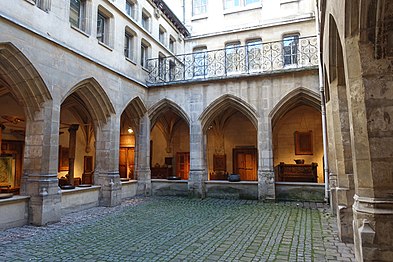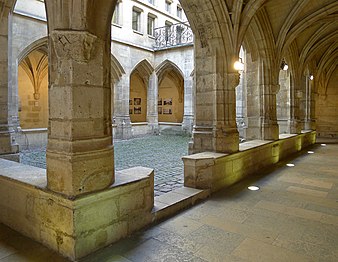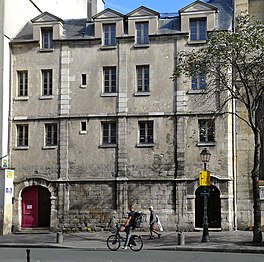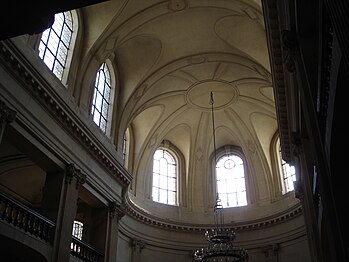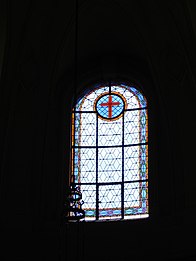Interior
The interior of the church is in the neoclassical style. The choir is round, surrounded with pilasters in the Corinthian style|. It is topped with a circle of windows with white glass, with a dome above. The windows and pilasters continue along the upper walls of the church to the portal. There are two levels of balconies or tribunes along the sides in the nave, supported by ionic style pillars. [4] The church originally had only one level of balconies; the upper was added in 1824 by the Duchess of Orleans, who was an important patron of the church. Her loge had a separate concealed entrance, so she could come and go easily. [5]
In keeping with the doctrine of the Lutheran church, the decoration of the choir is extremely simple; only the most essential elements are present; an altar, candles, a crucifix, and a lectern. The altar and lectern are recent creations made by Philippe Keppelin in the 20th century. [4]
The organ of the church is found in the tribune at the end of the nave, over the portal. It is a modern instrument, made by the factor Mülheisen in 1982–1983. [4]
Dome of the choir
Tribunes of the nave
Upper window
The portal and the organ

The Church of Sainte-Marie-Madeleine, or less formally, La Madeleine, is a Catholic parish church on Place de la Madeleine in the 8th arrondissement of Paris. It was planned by Louis XV as the focal point of the new Rue Royal, leading to the new Place Louis XV, the present Place de la Concorde. It was dedicated in 1764 by Louis XV, but work halted due to the French Revolution. Napoleon Bonaparte had it redesigned in the Neoclassical style to become a monument to the glory of his armies. After his downfall in 1814, construction as a church resumed, but it was not completed until 1842. The building is surrounded on all four sides by Corinthian columns. The interior is noted for its frescoes on the domed ceiling, and monumental sculptures by François Rude, Carlo Marochetti and other prominent 19th-century French artists.

Saint-Étienne-du-Mont is a church in Paris, France, on the Montagne Sainte-Geneviève in the 5th arrondissement, near the Panthéon. It contains the shrine of St. Geneviève, the patron saint of Paris. The church also contains the tombs of Blaise Pascal and Jean Racine. Jean-Paul Marat is buried in the church's cemetery.

The Church of Saint-Germain-des-Prés is a Roman Catholic parish church located in the Saint-Germain-des-Prés quarter of Paris. It was originally the church of a Benedictine abbey founded in 558 by Childebert I, the son of Clovis, King of the Franks. It was destroyed by the Vikings, rebuilt, and renamed in the 8th century for Saint Germain, a 6th century bishop. It was rebuilt with elements in the new Gothic style in the 11th century, and was given the earliest flying buttresses in the Ile-France in the 12th century. It is considered the oldest existing church in Paris.

The Church of Saint-Séverin is a Roman Catholic church in the 5th arrondissement, or Latin Quarter, of Paris, on the lively tourist street Rue Saint-Séverin. It was constructed beginning in 1230, then, after a fire, rebuilt and enlarged in the 15th to 17th centuries in the Flamboyant Gothic style. It was the parish church for students at the University of Paris, and is one of the oldest churches that remains standing on the Left Bank.

Saint-Gervais-Saint-Protais is a Roman Catholic parish church located in the 4th arrondissement of Paris, on Place Saint-Gervais in the Marais district, east of City Hall. The current church was built between 1494 and 1657, on the site of two earlier churches; the facade, completed last, was the first example of the French baroque style in Paris. The organists of the church included Louis Couperin and his nephew François Couperin, two of the most celebrated composers and musicians of the Baroque period; the organ they used can still be seen today. The church contains remarkable examples of medieval carved choir stalls, stained glass from the 16th century, 17th century sculpture, and modern stained glass by Sylvie Gaudin and Claude Courageux. Saint-Gervais was a parish church until 1975, when it became the headquarters of the Monastic Fraternities of Jerusalem.

Saint-Pierre de Montmartre is the second oldest surviving church in Paris, after the Abbey of Saint-Germain-des-Pres. It is one of the two main churches on Montmartre, the other being the more famous 19th-century Sacré-Cœur Basilica, just above it. Saint-Pierre de Montmartre, begun in 1133, was the church of the prestigious Montmartre Abbey, destroyed in the French Revolution.

French Baroque architecture, usually called French classicism, was a style of architecture during the reigns of Louis XIII (1610–1643), Louis XIV (1643–1715) and Louis XV (1715–1774). It was preceded by French Renaissance architecture and Mannerism and was followed in the second half of the 18th century by French Neoclassical architecture. The style was originally inspired by the Italian Baroque architecture style, but, particularly under Louis XIV, it gave greater emphasis to regularity, the colossal order of façades, and the use of colonnades and cupolas, to symbolize the power and grandeur of the King. Notable examples of the style include the Grand Trianon of the Palace of Versailles, and the dome of Les Invalides in Paris. In the final years of Louis XIV and the reign of Louis XV, the colossal orders gradually disappeared, the style became lighter and saw the introduction of wrought iron decoration in rocaille designs. The period also saw the introduction of monumental urban squares in Paris and other cities, notably Place Vendôme and the Place de la Concorde. The style profoundly influenced 18th-century secular architecture throughout Europe; the Palace of Versailles and the French formal garden were copied by other courts all over Europe.

Saint-Louis en l'Île is a Roman Catholic parish church located at 19 Rue Saint-Louis en l'Île on Île Saint-Louis in the 4th arrondissement of Paris, France. It was constructed between 1664 and 1725, and is dedicated to King Louis IX of France, or Saint Louis. The church was originally built in the French Baroque style of the 17th century, but much of the interior decoration was taken or destroyed in the French Revolution. The church was extensively restored and redecorated in the 19th century.
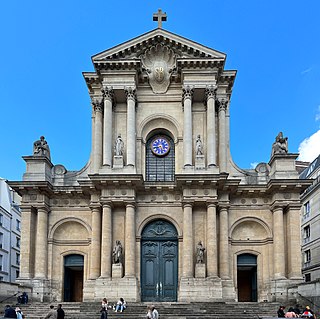
The Church of Saint-Roch is a 17th–18th-century French Baroque and classical style church in Paris, dedicated to Saint Roch. It is located at 284 rue Saint-Honoré, in the 1st arrondissement. The current church was built between 1653 and 1740.
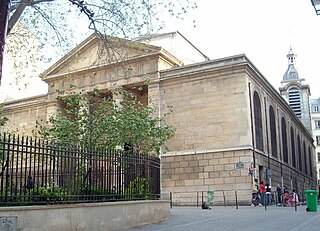
Notre-Dame-de-Bonne-Nouvelle, located at 25 Rue de la Lune, in the 2nd arrondissement of Paris and is a Catholic parish church built between 1823 and 1830. It is built in the Neoclassical style, and is dedicated to Notre-Dame de Bonne-Nouvelle, referring to the Annunciation. The neighbourhood of Bonne-Nouvelle, the Boulevard de Bonne-Nouvelle and the Bonne Nouvelle metro station are named after it. The church was registered as a national historical monument in 1983.

The Church of the Val-de-Grâce is a Roman Catholic church in the 5th arrondissement of Paris. The church was built as part of a royal abbey by Anne of Austria, the Queen of France, to celebrate the birth of her son, Louis XIV in 1638. Construction began in 1645 under the direction of architect François Mansart and was completed in 1665 by Gabriel Le Duc. The abbey and church were turned into a hospital during the French Revolution and then became part of the Val-de-Grâce Hospital, which closed in 1979. The church is attached to the diocese of the French military and is open to visitors at specified hours. Its dome is a landmark in the skyline of Paris.

The Church of Saint-Nicolas-des-Champs is a Catholic church in Paris' Third arrondissement. Early parts of the church, including the west front, built 1420–1480, are in the Flamboyant Gothic style, while later portions, including the south portal, mostly built 1576–86, are examples of French Renaissance architecture. It is notable particularly for its Renaissance carved sculpture, decoration and large collection of French Renaissance paintings in the interior.

The Église Saint-Paul-Saint-Louis is a church on rue Saint-Antoine in the Marais quarter of Paris. The present building was constructed from 1627 to 1641 by the Jesuit architects Étienne and François Derand, on the orders of Louis XIII of France. It was the first church in Paris to break away entirely from the Gothic style and to use the new Baroque style of the Jesuits, and it had an important influence on Parisian religious architecture. It gives its name to Place Saint-Paul and its nearest Metro station, Saint-Paul. Next door to the church is the Lycée Charlemagne, also founded by the Jesuits.

Notre-Dame des Blancs-Manteaux is a Roman Catholic parish church at 12 Rue des Blancs-Manteaux in Le Marais, in the 4th arrondissement of Paris. It takes its name from the "Les Blancs-Manteaux", for the cloaks worn by the mendicant Augustinian Order of Servites, who founded the first church 1258. It was rebuilt between 1685 and 1689 in the French Baroque or French neoclassical style. It is noted for its remarkable carved wood pulpit (1749) and its collection of paintings and sculpture.

Saint-Jacques du Haut-Pas is a Roman Catholic parish church in Paris, France. The church is located at the corner of Rue Saint-Jacques and Rue de l'Abbé de l'Épée in the 5th arrondissement of Paris. The first church on the site, a monastery chapel, was built in 1360. The present church was completed in 1685. The church is named for Saint-Jacques Du-Haut-Pas,", a cousin of Christ and the first bishop of Jerusalem, who was martyred in the year 60 A.D. It was registered as an historical monument on 4 June 1957.

Saint-Joseph-des-Carmes (Saint-Joseph-des-Carmes) is a Catholic church located at 70 rue de Vaugirard in the 6th arrondissement of Paris. It was originally built as the chapel of a convent of the mendicant order of Shoeless Carmelites. It is now the church of the Catholic Institute of Paris, a university-level seminary for training priests, and is also a parish church for the neighbourhood. It is dedicated to Saint Joseph, husband of the Virgin Mary. Built between 1613 and 1620, it combines elements of Classical architecture on the exterior with a remarkable display of Baroque architecture and art in the interior. The chapel is open to the public at limited hours.

The château d’Asnières is a stately home at 89 rue du Château in the town of Asnières-sur-Seine in Hauts-de-Seine, France.
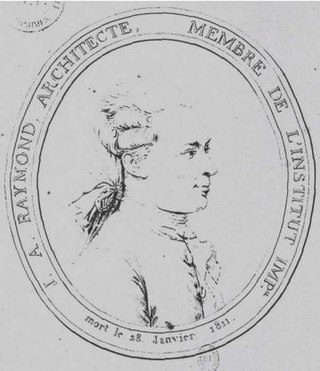
Jean-Arnaud Raymond was a French architect in the Palladian style.

Notre-Dame-de-la-Compassion is a Roman Catholic Church located on Place du Général Koenig in the 17th arrondissement in Paris. It was originally built in 1842–43 as a memorial chapel to Ferdinand Philippe, Duke of Orléans, the heir to King Louis-Philippe of France, who was killed in a road accident in 1842. It was built in the Neo-Byzantine style, with elements of Gothic, Baroque and other styles, and was originally called the Chapelle Royale Saint-Ferdinand. In 1970 it was moved stone by stone from its original location a short distance away to make space for the new Palais des Congrès. It became a parish church in 1993. Its notable decoration includes stained glass windows designed by Jean-Auguste-Dominique Ingres, and sculpture by Henri de Triqueti. It was designated a French historic monument in 1929.

Schloss Jägersburg was a palace in Jägersburg, part of Homburg in the Saar-Palatinate (Saarpfalz) district, Germany. Constructed in the 18th century by French architect Jacques Hardouin-Mansart de Sagonne, it was one of the most important residences he ever built, and the favourite hunting lodge of Christian IV, Duke of Zweibrücken. German Grand Trianon, it was destroyed during the French Revolutionary Wars and its last remains were demolished at the start of the 19th century. Today, nothing remains of one of the first neoclassical palaces in Germany.


